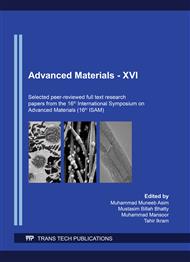[1]
J.Delmonte. Historical perspectives of composites", in International encyclopaedia of composites, Edited by Lee and Stuart M, New York: VCH Publishers, (1990).
Google Scholar
[2]
L.J. Broutman, R.H. Krock,Modern composite materials, Addison-Wesley press, (1967).
Google Scholar
[3]
A.B. Strong, Fundamentals of composites manufacturing- materials, methods, and applications, Society of manufacturing engineers, (1989).
Google Scholar
[4]
Information on http://www.tech.plym.ac.uk/sme/mats216/introduction.pdf, Composite materials basic concept and definitions.
Google Scholar
[5]
W.D. Callister, Materials science and engineering an introduction, 3rd Ed, JhonWiley and Sons, (1994).
Google Scholar
[6]
M.R. Piggot, Load bearing fiber composites, Pergamon press, Oxford, (1980).
Google Scholar
[7]
T.W. Chou, R.L. Mcculloughand R.B. Pipes, Composite, Scient.Ameri. Vol. 255, No.4, (1986).
Google Scholar
[8]
Information on http://courses.ahc.umn.edu/medical- school/BMEn/5001/notes/composites.htm - 21k, Introduction to composite materials.
Google Scholar
[9]
Information on http://www.azom.com/details.asp?ArticleID=962#_Composite_Theory, Composite theory- an introduction, site browsed on 20-01-(2019).
Google Scholar
[10]
J.Chmelar, Size reduction and specification of granular petrol coke with respect to chemical and physical properties, Ph.D Thesis, (Norwegian university of science and technology, Trondheim, 2006:74) p.13.
Google Scholar
[11]
F. Keller, U.Mannweilerand C.R. Perruchoud, Anode performance, The link between coke properties and aluminium production cost, Internal report 1994, published in, Anodes, R and D carbon ltd, 1st Ed 1995, Sierre , Switzerland.
Google Scholar
[12]
U.Mannweiler, Anode manufacturing: an introduction, RDC Internal report 1994, published in,Anodes, R and D carbon ltd, 1st Ed 1995, Sierre , Switzerland.
Google Scholar
[13]
R. Griffin, M. Keith and T.W. Fu, Method of making graphite electrodes nipple, US patent 4998709, date of patent, March 12, (1991).
Google Scholar
[14]
S.Y. Larsen, T. Foosnaes, H.A. Øye and Z. Yu, Carbon nanofibers in large scale electrode applications, Proceedings from Carbon 2005, CD version.
Google Scholar
[15]
Z. Fan, L. Liu, L. Jiangang, J. Song and C.Junling, Preparation of fine-grain carbon-ceramic materials by a ball milling dispersion method, Carbon 412003 1309-18.
DOI: 10.1016/s0008-6223(03)00070-8
Google Scholar
[16]
K.L. Sandvik, M. Digre and T. Malvik, Oppreding av primaere og sekundare rastoffer, Tapir forlag, Trondheim 1999, p-82.
Google Scholar
[17]
A.M. Nerland, Thermal shock resistance of anode carbon for aluminium electrolysis, Ph.D Thesis, (NTH, Universitetet I Trondheim Norges Tekniske Høgskole , 1994:71 pp.14-15.
Google Scholar
[18]
ISO 12985-2, Determination of apparent density and of open porosity using a hydrostatic method.
Google Scholar
[19]
ASTM C 1421-99, Standard test methods for determination of fracture toughness of advanced ceramics.
Google Scholar
[20]
P. Ouagne, G.B. Neighbour and B. McEnaney, Crack growth resistance in nuclear graphites. J.Phys.D: Appl. Phys. 352002 927-34.
DOI: 10.1088/0022-3727/35/9/315
Google Scholar
[21]
P. Ouagne, G.B. Neighbour and B. McEnaney,Influence of oxidation on toughness parameter for two nuclear grade graphities, J.Phys.D: Appl. Phys. 3820051259-64.
DOI: 10.1088/0022-3727/38/8/025
Google Scholar
[22]
S.Y. Larsen, Novel carbon materials, Internal CarboMat seminar, Trondheim 16th February (2006).
Google Scholar
[23]
X.L. Roy, V.Bhamidipati, W.H. ZhongJ.Li and M.C. Lukehart,Mechanical property characterization of a polymeric nanocomposite reinforced by graphitic nanofibers with reactive linkers., J.Comp.Mat. 38 2004 211-219.
DOI: 10.1177/0021998304043758
Google Scholar
[24]
K.Y. Choi, I.K. Sugimoto, M.S. Songand M. Endo, Mechanical and thermal properties of vapour-grown carbon nanofiber and polycarbonate sheet, Mat.Lett. 59 20053514-3520.
Google Scholar
[25]
C.Bower, R.Rosen, L. Jin, J.Han and O. Zhou, Deformation of carbon nanotubes in nanotube-polymer composites, App. Phy. Lett. 74 1999 3317-3319.
DOI: 10.1063/1.123330
Google Scholar
[26]
D. Qian, E.C. Dickey, R. Andrews and T.Rantell, Load transfer and deformation mechanics in carbon nanotube-polystyrene composites, App. Phy. Lett. 762000 2868-2870.
DOI: 10.1063/1.126500
Google Scholar
[27]
L.S. Schadler, S.C. Giannarisand P.M. Ajayan, Load transfer in carbon nanotube epoxy composites, App. Phy. Lett. 731998 2868-2870.
Google Scholar
[28]
H.G. Florian, H.G. Malte, B. Fiedler, U. Kopke and K. Schulte, Influence of different carbon nanotubes on the mechanical properties of epoxy matrix composites- A comparative study, Comp. Sci. Tech. 65 20052300-2313.
DOI: 10.1016/j.compscitech.2005.04.021
Google Scholar


